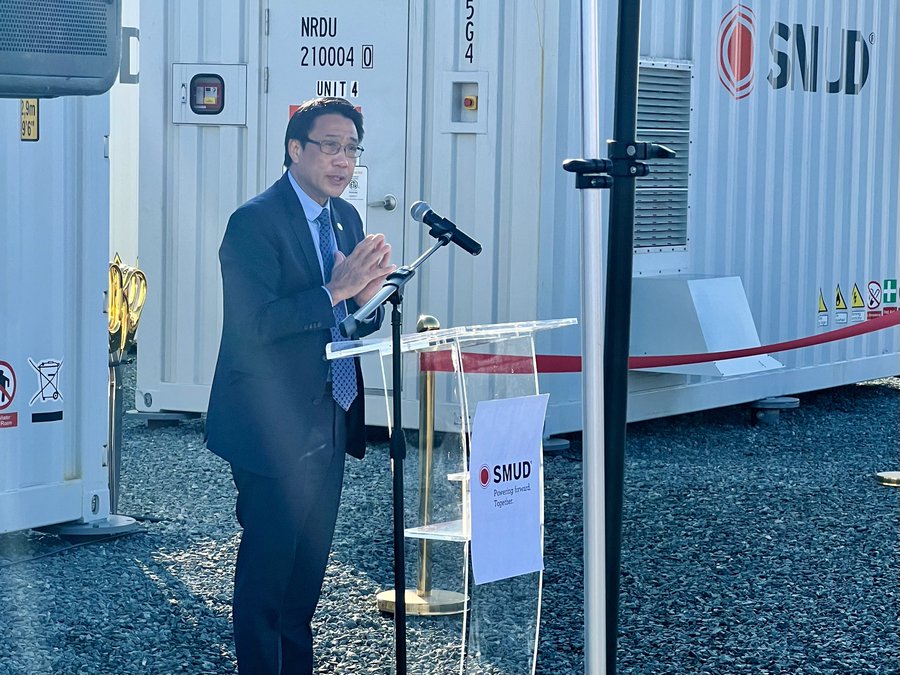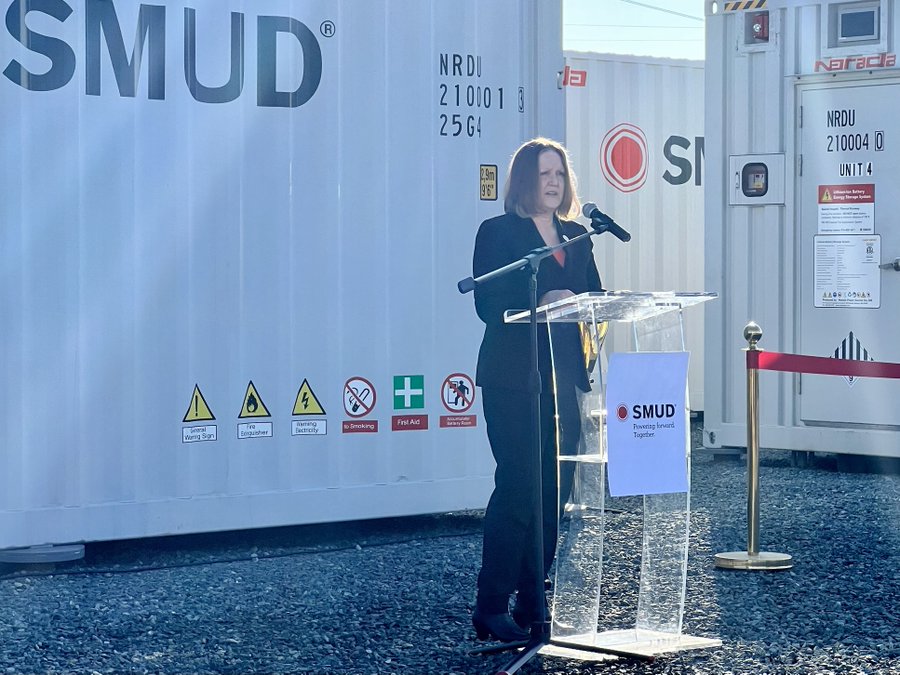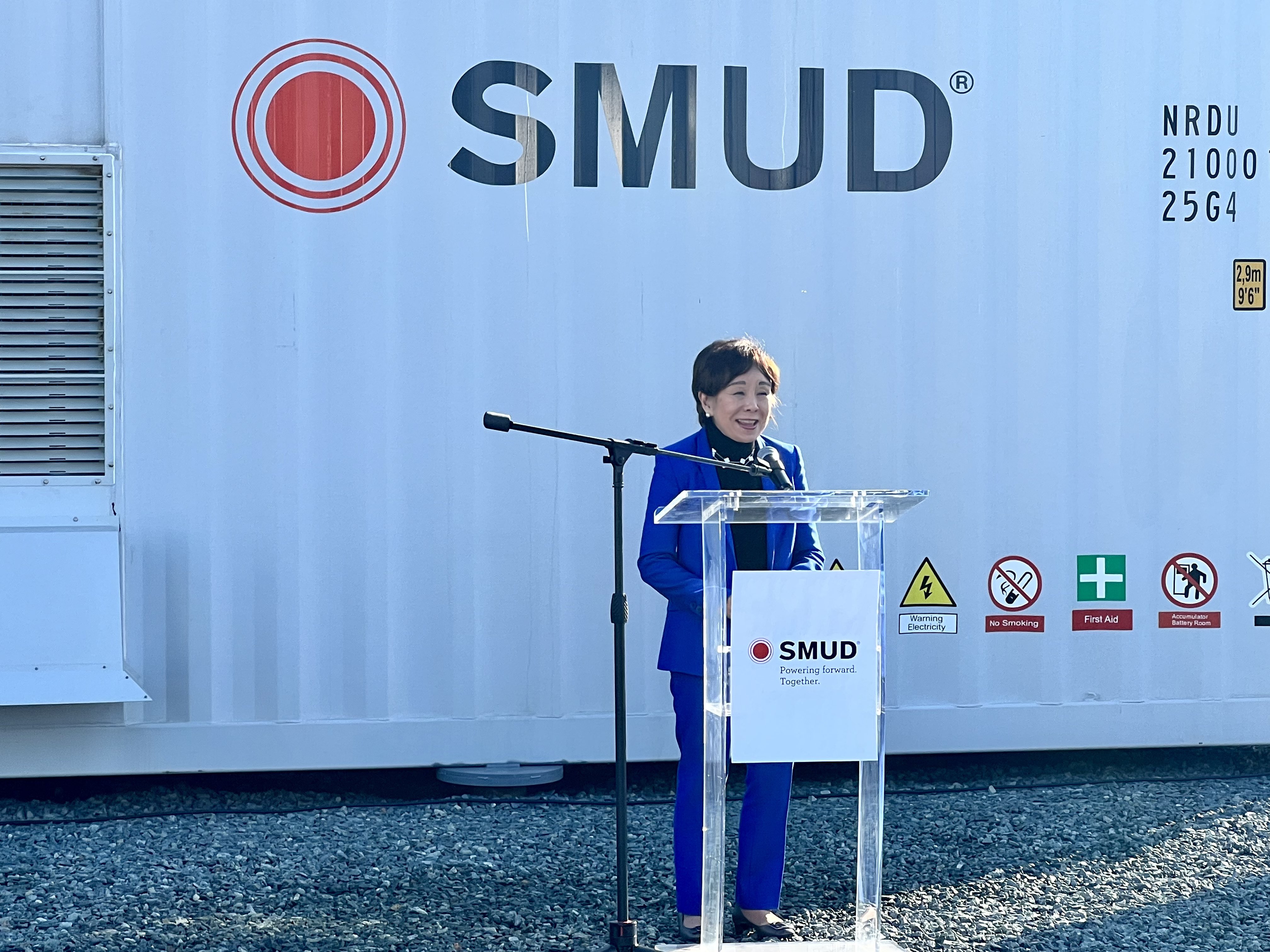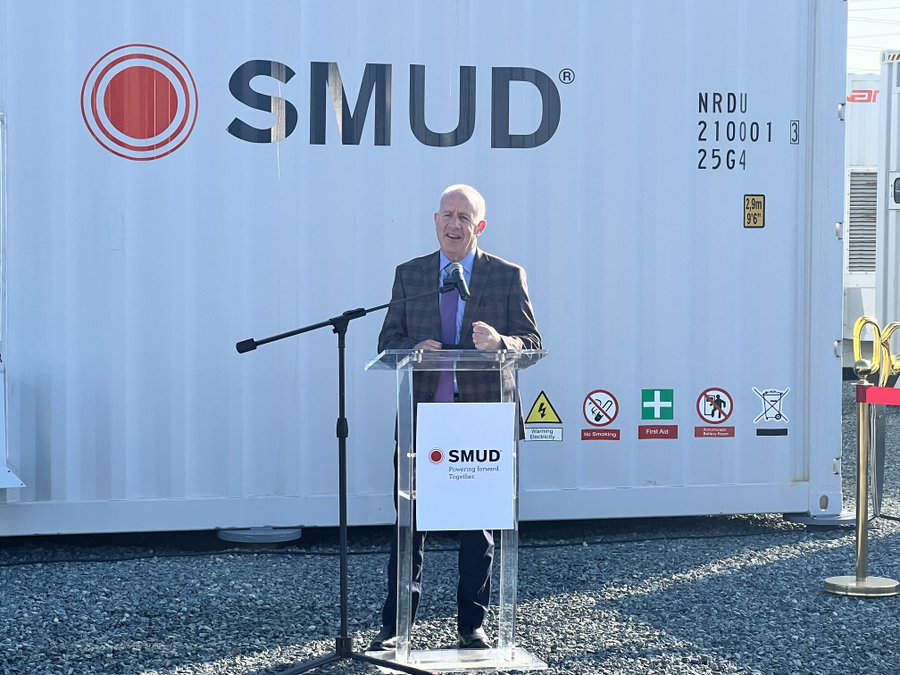DOE Launches Workforce Development Strategy For Lithium Battery Manufacturing
March 20, 2022
by Paul Ciampoli
APPA News Director
March 20, 2022
The U.S. Department of Energy (DOE) recently announced the launch of a national workforce development strategy for lithium battery manufacturing.
As part of a $5 million investment, DOE will support up to five pilot training programs in energy and automotive communities and advance workforce partnerships between industry and labor for the domestic lithium battery supply chain.
The pilot training programs will bring together manufacturing companies, organized labor, and training providers to lay the foundation for the development of a broad national workforce strategy, DOE noted.
The pilots will support industry-labor cooperation and will provide sites for job task analyses and documenting worker competencies, it said.
Insights gained will support the development of national industry-recognized credentials and inform the development of broader training programs to support the overall battery supply chain, DOE said.
This initiative comes as part of suite of announcements from President Biden’s Interagency Working Group (IWG) on Coal and Power Plant Communities and Economic Revitalization. This is a partnership among the White House and nearly a dozen federal agencies committed to pursuing near- and long-term actions to support coal, oil and gas, and power plant communities as the nation transitions to a clean energy economy, the DOE said.
DOE’s announcement follows its recent release of two Notices of Intent authorized by the infrastructure law to provide $3 billion to support projects that bolster domestic battery manufacturing and recycling.
The funding, which will be made available in the coming months, will support battery-materials refining, which will bolster domestic refining capacity of minerals such as lithium, as well as production plants, battery cell and pack manufacturing facilities, and recycling facilities, DOE said.
California Community Choice Aggregators Approve Long-Duration Energy Storage Contract
March 18, 2022
by Paul Ciampoli
APPA News Director
March 18, 2022
At a meeting of the California Community Power board in late February, members of the joint powers agency voted to enter into a contract for the 50-megawatt (MW)/400-megawatt hour (MWh) Goal Line long-duration energy storage project.
The lithium-ion battery storage project, developed by Onward Energy, will have eight hours of discharge duration and will be located in Escondido, California, with an expected online date of 2025.
California Community Power is comprised of 10 California community choice aggregators (CCAs).
In January, members of the joint powers agency voted to enter into an energy storage service agreement with REV Renewables for 69 MW/552 MWh of long-duration energy storage. The REV Renewables Tumbleweed project will be a CAISO grid-connected, lithium-ion battery storage resource located near Rosamond, in Kern County, California, with an expected online date of 2026.
The joint procurement effort for long-duration energy storage is a continuation of an October 2020 request for offers (RFO) seeking to procure cost-effective and viable long-duration storage resources.
A subset of California Community Power member CCAs issued the RFO prior to a California Public Utilities Commission (CPUC) procurement order.
The Goal Line and Tumbleweed contracts will allow the participating CCAs to meet their obligation for the long-duration energy storage requirement mandated by the CPUC.
Participation in the RFO and resulting projects is voluntary for each California Community Power member.
The participating agencies for the Goal Line project are CleanPowerSF, Redwood Coast Energy Authority, San Jose Clean Energy, Silicon Valley Clean Energy, Sonoma Clean Power Authority, and Valley Clean Energy.
The governing boards of each participating member will follow their local review and approval processes for the contract and associated agreements for the Goal Line project.
The American Public Power Association has initiated a new category of membership for community choice aggregation programs.
DOE Lab Leads Investigation To Better Understand Geothermal Lithium Resources
March 14, 2022
by Vanessa Nikolic
APPA News
March 14, 2022
In a new project sponsored and funded by the U.S. Department of Energy’s (DOE) Geothermal Technologies Office, the Lawrence Berkeley National Laboratory (LBNL) will work with scientists from the University of California (UC), Riverside, and Geologica Geothermal Group, Inc., to evaluate the lithium in the geothermal field beneath California’s Salton Sea.
The need for the project results from a recent push by California and other states to expand the adoption of electric vehicles, which increases demand for more batteries, and the lithium needed to make those batteries.
According to LBNL, the Salton Sea potentially holds enough lithium to meet all of the country’s domestic battery needs. Researchers hope to answer how much of the lithium can be extracted from the sea in a sustainable way.
There are currently 11 commercial plants at the Salton Sea producing geothermal energy, a renewable form of energy, in which the heat from hot fluids pumped up from the underground are converted to electricity.
The project is the first extensive scientific effort to outline California’s “Lithium Valley” and get a thorough understanding of the sea’s mineral-rich underground geothermal system.
LBNL and its partners will use an electron microscope and other advanced analytical tools to discover the mineral sources of lithium and its additional benefits.
The project team will also research potential environmental impacts to assess how much water and chemical usage is needed for lithium extraction and air quality during the extraction process.
DOE’s Geothermal Technologies Office says the project will provide critical insights about the subsurface that will help secure a domestic lithium supply chain using the most environmentally responsible and data-driven pathway.
Various companies have kicked off pilot operations at the Salton Sea to extract lithium, including Berkshire Hathaway Energy, a holding company, and Controlled Thermal Resources, a lithium resource and renewable energy company. LBNL and UC Riverside will use data from the companies active in the area and field data from the state of California’s Geologic Energy Management databases.
The project’s vision is for the lithium from the geothermal field beneath the Salton Sea to one day form the foundation for a new domestic battery industry in the U.S.
CPS Energy In Texas Signs Deal For Underground Pumped Storage Project
March 9, 2022
by Peter Maloney
APPA News
March 9, 2022
CPS Energy, the public power utility serving San Antonio, Texas, has signed a deal with Quidnet Energy for a pumped energy storage project that could eventually be as large as 15 megawatts (MW).
The 15-year agreement calls for an energy storage project employing Quidnet’s geomechanical pumped storage (GPS) technology. The plan calls for the project to be developed in two phases, starting with a 1-MW, 10-hour storage facility.
Quidnet’s technology uses off-peak electricity to pump water from a holding pond into an impermeable rock under the ground where it is held under pressure until the pressurized water is released to power a hydroelectric turbine. The closed loop process is designed to conserve water by reusing it and minimizing evaporation.
The technology employs much of the same expertise, workforce, and supply chains that are used to drill for oil and gas, and it uses conventional drilling technology and off-the-shelf hydropower equipment, Quidnet said. The technology can also be deployed across a diverse range of geographic locations and be scaled by using modules that go from 1 MW in size up to 10 MW, the company said.
“Incorporating Quidnet’s homegrown-Texan energy storage solution allows us to create a cleaner electric supply while supporting our local energy industry workforce and lowering costs for our customers,” Rudy Garza, interim president and CEO of CPS Energy, said in a statement.
CPS Energy also said the energy storage project would support its Flexible Path Resource Plan that aims to reduce the utility’s net emissions by 80 percent by 2040.
Under its Flexible Path Resource Plan CPS Energy’s intends to close coal plants, integrate technologies like energy storage and electric vehicles, expand the use of renewable resources, and add more programs and services such as energy efficiency and demand response. CPS aims to increase its renewable resources by 127 percent by 2040 while decreasing gas- and coal-fired generation by 72 percent and 61 percent, respectively.
Last year a Department of Energy study found that hydropower, including pumped hydro storage facilities, could be critical to ensuring the reliability of the nation’s electric grid during extreme weather events.
Quidnet has developed energy storage test sites in Medina and San Saba counties in Texas and is working on pilot projects in Ohio, New York, and Alberta, Canada. In addition to venture capital backing, Quidnet has received support from the Department of Energy, the New York State Energy Research and Development Authority, and Emissions Reduction Alberta.
Battery Storage System For Virginia’s Danville Utilities Slated For May Completion
March 7, 2022
by Paul Ciampoli
APPA News Director
March 7, 2022
Construction of a battery storage system for Virginia public power utility Danville Utilities is underway. The system will reduce the city’s energy demand during peak usage times and lower power costs for the city.
The battery storage system has a rated capacity of 10.5 megawatts (MW) and 24.6 megawatt hours, meaning it can provide approximately 10.5 MW of power for almost 2.5 hours during the peak events that determine the city’s costs for transmission service and power capacity.
Using the stored energy during these times will reduce the city’s electricity demand during these peak hours and help prevent increases in the future cost of electricity, Danville Utilities said
“The savings from this project are much greater than paying the transmission costs,” Jason Grey, director of Danville Utilities, said on March 3.
The battery project is being installed, operated, and maintained by Delorean Power. Delorean Power is an Arlington, Virginia-based company that is developing battery energy storage projects across the mid-Atlantic, Northeast, and Midwest.
The project was approved by the Danville City Council in January 2021, but there have been delays in the project’s completion due to the pandemic.
The project is expected to be complete and operational in May.
North Carolina Utility Uses APPA Grant To Test Peak Shaving Batteries
February 24, 2022
by Peter Maloney
APPA News
February 24, 2022
Greenville Utilities Commission in North Carolina has added a 1-megawatt (MW) battery energy storage system (BESS) to its grid using a Demonstration of Energy & Efficiency Developments (DEED) grant from the American Public Power Association.
Greenville Utilities was looking for ways to reduce its coincident peak load. Historically the public power utility had used peaking plants, such as a reciprocating engine, for peak shaving. But under an agreement with Duke Energy Progress and North Carolina Eastern Municipal Power Agency (NCEMPA), Greenville Utilities has limits on how much load side generation it can add to its system.
“The allocation was set in the 1990s and was used up; we were looking at other alternatives,” John Worrell, Greenville Utilities’ director of electric systems, said.
Batteries do not count as generation, but Duke has pushed back on that view. In September 2020, the Federal Energy Regulatory Commission (FERC) sided with NCEMPA, allowing the joint action agency to use energy storage devices to reduce demand.
The pilot project was a good way to test the performance and economics of an energy storage system and compare it to the performance of a peak shaving engine, Worrell said. Greenville Utilities received financial assistance from the DEED program, which awarded the utility a $125,000 grant toward the total budgeted $1.6 million cost of the pilot project.
Construction on the project began in June 2020 and the battery came online in November 2020. The energy storage system includes a 1,000-kilowatt (kW), 2,250-kilowatt hour (kWh) lithium iron phosphate batteries.
The project required a year’s worth of data, so the pilot closed out last December. The DEED report was filed at the end of last month. The battery system, however, continues to operate and perform peak shaving duties for Greenville Utilities.
Overall, the project was a success, Worrell said, though there were some issues with batteries overheating, which in some instances restricted their availability during some peak periods. Those issues are being worked out with Powin, the manufacturer of the batteries, Worrell said.
The 12 months of data collected on the battery energy storage system showed that it consumed 106,191 kWh comprised of 33,921 kWh of auxiliary load and 72,207 kWh from charging events. The battery system discharged an average monthly peak supply of 965 kW with a max of 999 kW. A 1,000-kW discharge was recorded at 15-minute intervals but was not sustainable during a full hour as preferred.
Greenville Utilities serves about 71,000 electric customers with an average non-coincident peak demand of 301,500 kW and a coincident peak demand of 255,900 kW, consuming approximately 150 gigawatt hours monthly.
In terms of load management, the battery system operated 54 times for a total duration of 94.5 hours. The average duration per operation was approximately 1.76 hours with a maximum of 2.13 hours.
During the coincident peak hour, the battery system was able to discharge during 11 of 12 hours, resulting in an average monthly coincident peak load reduction of 779 kW with a maximum load reduction of 999 kW. The overheating issue affected total potential peak shaving capability for the months of May, June, August, and September.
Nonetheless, because it reduced monthly coincident peak demand, the battery system was able to avoid $218,743 in demand charges. The total expenses incurred operating the battery system were $43,414, resulting in an annual net savings of $175,328 with the ability to save approximately 62.4 percent of the total potential avoided demand charges.
The performance of the battery system ranked third among Greenville Utilities’ 12 peak shaving generators of various sizes in providing a high saving potential, according to the DEED report. The top ranked peak shaving generators were able to achieve 70.3 percent of total potential avoided cost. However, if the battery system’s average coincident peak load reduction of 779 kW were improved and equivalent to the average peak supply of 965 kW, the battery system would have ranked first with a saving potential of 82.2 percent, according to the DEED report.
Greenville Utilities said it plans to continue operating the energy storage pilot project for peak shaving applications because of the benefits it has provided in avoiding monthly coincident peak demand costs.
The utility also plans to continue to analyze the project to prepare for future projects as they arise. So far, Greenville Utilities is not considering installing another battery storage system. It is considering and has under discussion an energy storage tolling agreement.
Greenville Utilities did very well with the cost of its battery system, but that could be more difficult to replicate in the future because of rising costs, Worrell said. In addition, the cost of off-peak power to charge the batteries could go up as natural gas prices rise.
Alternatively, under a tolling agreement, a third party installs and owns the battery and the utility pays a set fee for peak shaving services. The agreements are usually based on coincident peak charges.
“If the toller takes the risk and we get a locked-in demand charge, we can hedge our peak demand over time, as long as the coincident peak from our supplier does not drop,” Worrell said. The agreement avoids the capital costs of installing a battery storage system while providing certainty of savings on coincident peak demand charges, he said.
Overall, Worrell said he would recommend using battery energy storage to reduce demand charges. Thanks to the pilot program, “we now know battery storage is a viable option with the same risks as a generator and just as reliable,” he said.
Members of APPA’s DEED Program can visit the Greenville project’s DEED Project Library page for access a useful Excel-based calculator which compares the financial feasibility of installing future BESS and RICE for peak-shaving applications, useful datasets containing hourly- and quarter-hourly performance data for Greenville’s BESS, photos, a spec sheet, and the full final report.
Greenville Utilities is a publicly owned utility in Pitt County that provides electric, water, sewer, and natural gas services to the City of Greenville and 75 percent of Pitt County. It is also the largest member of NCEMPA.
California 300-MW Energy Storage Facility Goes Offline
February 16, 2022
by Paul Ciampoli
APPA News Director
February 16, 2022
A 300-megawatt (MW) energy storage facility in California is offline at the same site where another storage facility went offline last year.
Late on February 13, the early detection safety system activated in the 100-MW Phase II building at Vistra’s Moss Landing Energy Storage Facility, Vistra reported.
“As is our protocol at all of our facilities, we contacted off-site emergency response out of an abundance of caution. The building’s systems contained the event without the need for the outside assistance. There are no injuries to personnel. An investigation is underway to determine what caused the safety system to activate,” the company said.
While this is in its very early stages, “what we know is the water-based suppression system released water that contacted some batteries.”
Vistra said that there is early evidence that water hoses leaked and that some batteries shorted, creating smoke in the building, similar to what was observed with a September 2021 incident at Vistra’s 300-MW Phase I facility next door.
The suppression system contained the event, and the 100-MW Phase II system is currently offline.
The Phase I facility was not affected by Sunday’s incident. “We have been in the process of incrementally bringing the Phase I facility back online but have decided to pause restart activities while we assess the Phase II incident and will incorporate any learnings,” the company said.
DOE To Provide $2.91 Billion To Boost Production Of Advanced Batteries
February 13, 2022
by Paul Ciampoli
APPA News Director
February 13, 2022
The U.S. Department of Energy (DOE) recently issued two notices of intent to provide $2.91 billion to boost production of advanced batteries, including for electric vehicles and energy storage, as directed by the bipartisan infrastructure law.
DOE intends to fund battery materials refining and production plants, battery cell and pack manufacturing facilities, and recycling facilities that create good-paying clean energy jobs.
The funding is expected to be made available in the coming months.
In June 2021, DOE published a 100-day review of the large-capacity-battery supply chain, pursuant to Executive Order 14017, America’s Supply Chains. The review recommended establishing domestic production and processing capabilities for critical materials to support a fully domestic end-to-end battery supply chain.
The infrastructure law allocates nearly $7 billion to strengthen the U.S. battery supply chain, which includes producing and recycling critical minerals without new extraction or mining, and sourcing materials for domestic manufacturing.
Funding from the law will allow DOE to support the creation of new, retrofitted, and expanded domestic facilities for battery recycling and the production of battery materials, cell components, and battery manufacturing.
The funding will also support research, development, and demonstration of second-life applications for batteries once used to power EVs, as well as new processes for recycling, reclaiming, and adding materials back into the battery supply chain.
Both forthcoming opportunities are aligned with the National Blueprint for Lithium Batteries, guidance released last year by the Federal Consortium for Advanced Batteries and led by DOE alongside the Departments of Defense, Commerce, and State. The blueprint details a path to ensuring a domestic battery supply and accelerating the development of a domestic industrial base by 2030.
Those interested in applying for the upcoming funding opportunities are encouraged to register to receive notifications about key dates within the application process by signing up for the Vehicle Technologies Office newsletter.
The notices are available here.
Click here for resources and opportunities for public power tied to the infrastructure law curated by the American Public Power Association.
California Community Choice Aggregators Enter Into Storage Service Agreement
January 30, 2022
by Paul Ciampoli
APPA News Director
January 30, 2022
A group of California community choice aggregators (CCAs) recently voted to enter into an energy storage service agreement with REV Renewables for 69 megawatts/552 megawatt hours of long-duration energy storage.
The REV Renewables Tumbleweed project will be a California Independent System Operator grid-connected, lithium-ion battery storage resource located near Rosamond, in Kern County, California, with an expected online date of 2026.
The CCAs are members of California Community Power, a joint powers agency.
The participating CCAs are: CleanPowerSF, Peninsula Clean Energy, Redwood Coast Energy Authority, San Jose Clean Energy, Silicon Valley Clean Energy, Sonoma Clean Power Authority and Valley Clean Energy. Participating members will follow their own review and approval processes with their local, elected boards.
The California Public Utilities Commission (CPUC) Mid-Term Reliability Procurement order requires all CPUC-jurisdictional load serving entities, including CCAs, to procure from energy storage facilities capable of discharging for a minimum of 8 hours.
The Tumbleweed project satisfies approximately 55% of the long-duration storage compliance requirements of the participating members.
The joint procurement effort by the CCAs for long-duration energy storage began before the CPUC issued the new procurement order when a subset of the CCAs issued a Request for Offers (RFO) in October 2020 seeking to procure cost effective and viable long-duration storage resources.
Participation in the RFO and resulting projects is voluntary for each joint powers agency member.
The American Public Power Association has initiated a new category of membership for community choice aggregation programs.
SMUD Unveils First Utility-Scale Storage Battery Project
January 26, 2022
by Paul Ciampoli
APPA News Director
January 26, 2022
Officials from California’s Sacramento Municipal Utility District (SMUD) on Jan. 24 were joined by regional leaders for a ribbon-cutting of SMUD’s first utility-scale storage battery project.
With the ribbon cutting, the public power utility unveiled six large-scale lithium-ion battery storage units at the Hedge Solar Farm in south Sacramento, a pilot project that will demonstrate the feasibility of utility-scale battery storage.

The large-scale lithium-ion battery system is a step forward in SMUD’s vision to add 1,100 megawatts (MW) of battery storage over the next decade, a keystone to the utility’s 2030 Zero Carbon Plan.
Hedge Solar Farm batteries will provide 4 MW of electricity and 8 megawatt-hours of storage. The six battery containers are 20 feet long, weigh 52,000 pounds each, and house 3,840 interconnected battery cells.

This is the largest battery installation in the greater Sacramento area and the first of its kind for a publicly owned utility in California, SMUD said.
The following officials attended the ribbon cutting:
SMUD CEO and General Manager Paul Lau
Rep. Doris Matsui, D-Calif.
SMUD Board of Directors Vice President Heidi Sanborn
Sacramento Mayor Darrel Steinberg
Sacramento Councilman Eric Guerra
California Assemblymember Kevin McCarty
California Assemblymember Ken Cooley
Matthew Nelson of Electrify America
John Roeser of Mitsubishi


